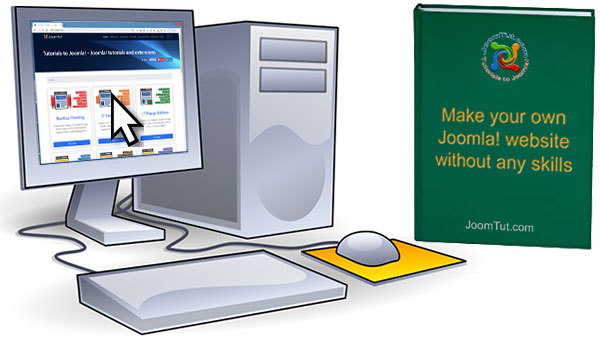
Step by step to create your own website without any skill and coding knowledge. Starting from nothing to have everything, including managing the server to run the website and ready to make money from your website or to be a programming and web designer.
Introducing
First of all you need to know a little about the website and how it works. A website - also written as web site - is a collection of web pages and related content that is identified by a common domain name and published on at least one web server. As you known, our website is joomtut.com
Read more: What is a website?
In this tutorial, we will show you how to make a dynamic website with Joomla! A completely free and open source content management system - CMS.
Joomla! is an award-winning content management system - CMS, which enables you to build websites and powerful online applications. Many aspects, including its ease-of-use and extensibility, have made Joomla! the most popular website software available. Best of all, Joomla! is an open source solution that is freely available to everyone.
Read more: What is Joomla?
After you already understand everything, we will start to do it now.
Step by step to create your own website without any skill
Step 1 - Register a Domain Name for your website
Your website needs a name, it is called a domain name. You can register or buy a domain name from any of the top domain registrars that are authorized by ICANN to register domain names.
Read more: What is domain name and how to choose a best Domain Name
Please register a domain name at the best online domain name registrar website:
If you sign up for any hosting plan at Bluehost or NameCheap you will get a free domain name.
If all the good domains are taken, you can buy premium domain at domains market:
Read more: How to register a Domain Name?
Step 2 - Rent a place to host your website
You need a place to store your website, where people can access it. It can be any where but certainly not your computer.
Read more: What is the web server and what is the web hosting?
- If your website is small and personal site or blog, you only need to rent a shared hosting at Bluehost or NameSilo or NameCheap
If you sign up for any hosting plan at Bluehost or NameCheap you will get a free domain name.
- If your website is small companies and businesses or E-commerce, you need to rent a Virtual Private Server - VPS at DigitalOcean or Vultr You can start with the lowest standard plan at $5/month
Read more: How to choose a hosting for Joomla! website?
Step 3 - Setup your web server
- If you rent a shared hosting, please skip this step because everything is ready for you.
- If you rent a private virtual server - VPS, you need to create your web server.
Read more: How to setup a new private virtual server - VPS at DigitalOcean
To connect to your server, you will need a program called PuTTY.
Read more: How to make an SSH connection to your server using PuTTY
You need to install a web application for your website to run. You also need a control panel to help manage the operation of your website.
On shared hosting, usually you will have a control panel called cPanel. In case of using a virtual private server - VPS, you need to install a control panel called VestaCP.
Read more: How to install Vesta Control Panel - VestaCP on VPS
Step 4 - Point your Domain Name to your web server
You have a domain name and a web host, and now you need to connect them together so visitors can access your website through your domain.
- If you have a shared hosting with domain name, please skip this step because everything is ready for you.
- If you register a domain with a registrar separate from the shared hosting provider, you need to connect your domain name to your shared hosting.
- If you setup a new private virtual server - VPS, you need to connect your domain name to your VPS.
Read more: How to point your domain name to new web server
Step 5 - Creating a new email account
You may need an email box under your domain name to contact your website visitors.
Read more: How to create an email account in cPanel on shared hosting
Read more: How to create an email account in VestaCP on private virtual server - VPS
Step 6 - Creating a new FTP account to manage your files on hosting
FTP account is used for uploading, downloading and managing files on your website. By default, , an FTP account is automatically created when you sign up for shared hosting or setup your web server. You can use your username and password to log into it.
You can create new FTP accounts to give access to other users without giving them your admin login credentials. For each additional FTP account created, you can also give each user different levels of access by assigning the user to a specific directory.
Read more: How to create an FTP account in cPanel on shared hosting
Read more: How to create an FTP account in VestaCP on VPS
You also need an FTP client program to manage your files on your shared hosting or server.
Read more: How to make a FTP connection to your server using FileZilla Client
Step 7 - Creating a new database for your website
Your website needs a database to operate. Therefore you need to create it before installing Joomla!
Read more: How to create a database in cPanel on shared hosting
Read more: How to create a database in VestaCP on private virtual server - VPS
Step 8 - Install the Joomla! website on your web host
To prepare for install Joomla! you will need to download and Upload Joomla! Package Files to your web host. There will be a difference when you do this on shared hosting or virtual private server.
Read more: How to upload and extract Joomla! installation package on cPanel shared hosting
Read more: How to get and unzip Joomla! installation package on private virtual server – VPS
There is no significant difference when you install Joomla! These apply whether you have a dedicated server, a shared hosting plan server, or are installing a copy on a local computer for testing or development. You only need to follow the instructions to complete the installation of Joomla! easily.
Read more: How to install Joomla!
Watch video clip: How to create a website without any skills
Watch video clip: How to create a Joomla! website quickly
Watch video clip: How to create a Joomla! website with free Plesk license


